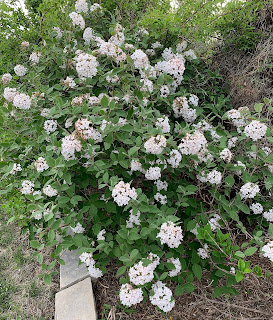 |
| Hibiscus syriacus 'Sugar Tip' |
If a happy place exists in my arid, almost-August garden, it would have to be near this Rose of Sharon,
Hibicus syriacus 'Sugar Tip'. I know the colors of the photos here are a little muted by the hazy sky within the not-yet-entirely-risen morning sun, but 'Sugar Tip' is a very pleasing blend of cream-tipped matte foliage that frames the clear, pink blossoms, and it is a fantastic focal point when nothing else is blooming nearby.
 |
| 'Sugar Tip', 2 years planted |
'Sugar Tip' is a mere adolescent,
present in my garden since 2015, and she also goes by the name of 'American Irene Scott'. Discovered in 2001 and patented by Spring Hill Nursery, She is touted as a refined Rose of Sharon, reported to have a semi-dwarf habit for shrubs of her type, although she is easily expected to grow 6 feet tall and nearly as wide. I do find that she is restrained in her habits in my garden, gracious to the shrubs and roses around her, unlike a massive pussy-willow that grows in the same bed. 'Sugar Tip' is a "triple-threat" garden plant, if I can borrow that hardwood term here in baseball season, providing a spectacle in the garden in three seasons as she adds leaves, shows off those delicate, double 2.5 inch flowers, and then self-cleans back to eye-catching foliage in late summer.
 |
| Hibiscus syriacus 'Double Red' |
If I didn't know better, I would have guessed that 'Sugar Tip' was a sport of another
Hibiscus in my garden, the more mundane 'Double Red'. Although 'Sugar Tip' is supposed to be a chance seedling, the blossoms of both are identical, light pink and double, 'Double Red' only lacking the cream-tinted edges.
 |
| Hibiscus rojo 'Red Heart' |
For sheer blossom power right now, however, neither can match
Hibiscus rojo 'Red Heart'. 'Red Heart' has much larger blossoms, single-petaled, with the bright red center surrounding a towering yellow pistol group. Unfortunately, one only notices 'Red Heart' in my garden from the rear of the garden because I placed her on the far side of a bed, hidden from the front by an oak and other shrubs. She is one of those plants that I notice only when I mow, or when I'm on a full tour of my garden beds. In her presence, I stop and look at each bloom individually, reveling in the deep soul of each heart.
In the King James Bible, Song of Solomon chapter 2, verse 1, the beloved says "I am the rose of Sharon, and the lily of the valleys." In my garden, there are many beloved ladies worthy of being called the "rose of Sharon", each with its own special beauty and charm. Right now, they all shine, content to bask in the heat of the August sun, supremely confident in their unrivaled glory.
.jpg)
.jpg)
.jpg)
.jpg)
.jpg)
.jpg)
.jpg)
.jpg)
.jpg)
.jpg)
.jpg)
.jpg)
.jpg)
.jpg)
.jpg)
.jpg)









.jpg)
.jpg)






